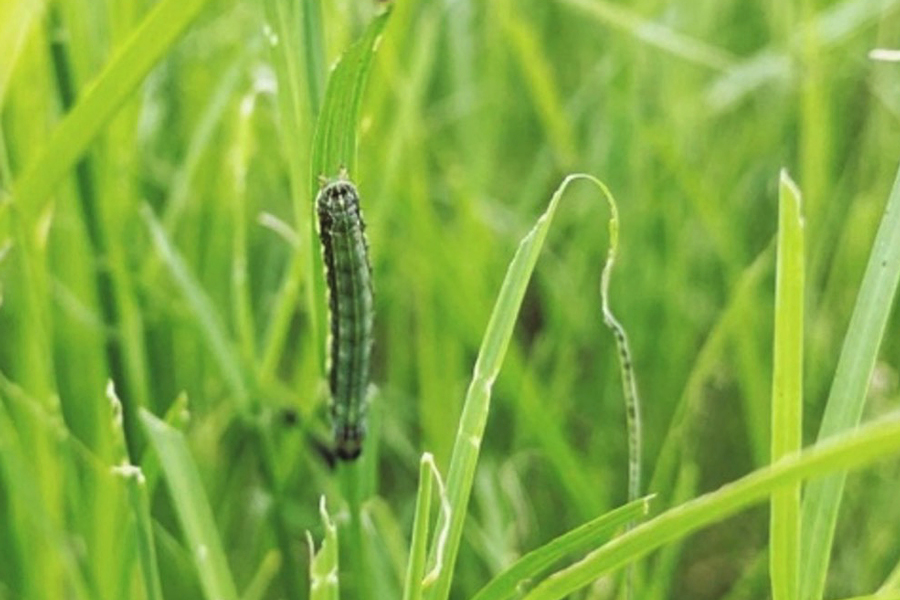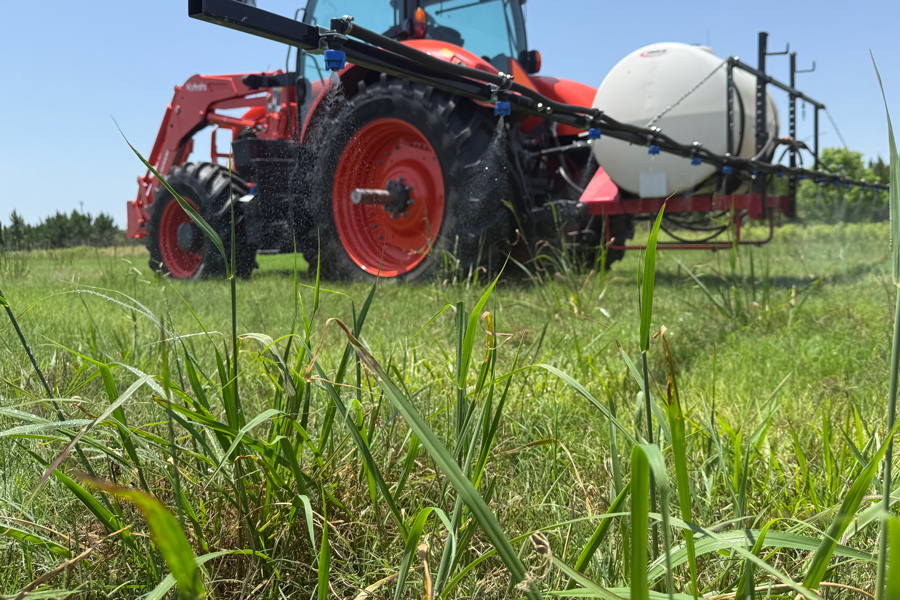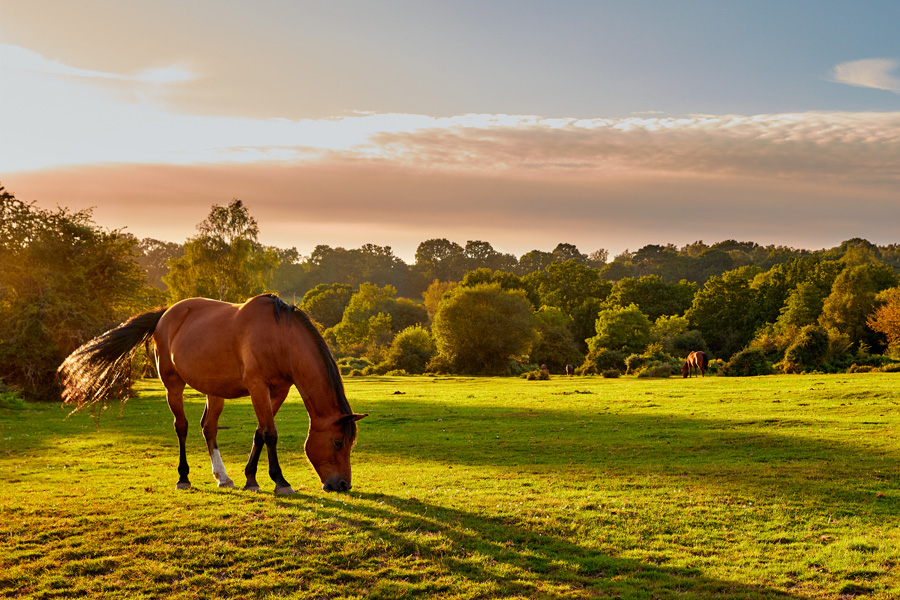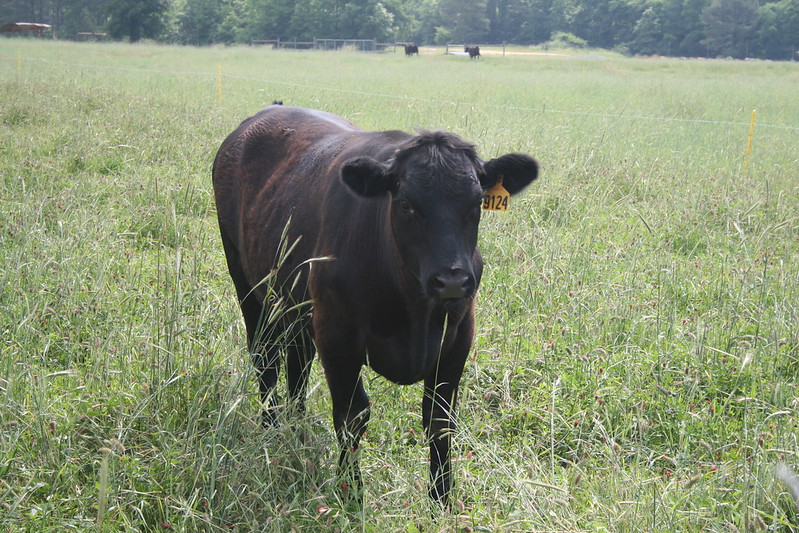Annual forages are an excellent tool for bridging the production gaps left by perennial forage systems. Since bermudagrass and bahiagrass are warm-season forages, there will be a gap in forage production from approximately November to April each year. On the other hand, tall fescue is a cool-season forage and will have a gap in forage production from approximately June to September. Livestock will need to be supplemented during this period with stored forages or supplementation if other grazing is not available. Annual forages are a low-cost way to meet the nutritional demands of the herd or flock during these periods.
Many agronomic crop producers will use annual forages for cover crops, especially cool-season annual grasses, between cash crop harvest in the fall and planting of the next crop in the spring. In this scenario, the continuous ground coverage and residue that remains at planting is valuable to the soil; however, using the cover for grazing or harvesting it for livestock can provide another opportunity to capitalize on the investment and/or generate more income. This resource discusses the essential aspects of planting and growing annual forages in Georgia.
Recommended Annual Forages for Broad Adaptation
The most common grasses, legumes, and forbs grown for annual forage production in Georgia are detailed in Table 1.
| Species | Planting rate (lb/acre)1 | Planting depth (in.) | |
|---|---|---|---|
| Pure stand | Mixture | ||
| Warm-season annual grasses | |||
| Crabgrass | 3–5 | 2–3 | ¼ |
| Pearl millet | 12–15 | 8–10 | ½–1 |
| Sorghum | 6–8 | 4–5 | ½–1 |
| Sudangrass | 10–15 | 7–10 | ½–1 |
| Sorghum × sudangrass | 15–20 | 10–13 | ½–1 |
| Cool-season annual grasses | |||
| Annual ryegrass (diploid or tetraploid) | 20–25 | 15–25 | ¼–½ |
| Oat | 90–120 | 60–90 | ½–1 |
| Rye | 90–120 | 60–90 | ½–1 |
| Triticale | 90–120 | 60–90 | ½–1 |
| Wheat | 90–120 | 60–90 | ½–1 |
| Cool-season annual legumes | |||
| Arrowleaf clover | 5–8 | 5–6 | ¼ |
| Ball clover | 2–3 | 1–2 | ¼ |
| Berseem clover | 15–18 | 10–15 | ¼ |
| Crimson clover | 15–25 | 10–12 | ¼ |
| Cool-season annual forbs | |||
| Brassicas (diploid or tetraploid) | 3–4 | NR2 | ¼ |
|
1 The planting rates listed in this table are recommended to optimize forage production.
If the crop will only be used as a ground cover, the planting rate may be reduced by 20%–30%. 2 Brassicas are not broadly recommended for use as part of a mixture because most livestock will selectively avoid these plants. |
|||
These forages may be grown individually or in a mixture. A mixture refers to two or more forages being grown in the same space at the same time. Mixtures can be planted together as a seed blend if the seeding rate and depth are comparable. If the recommended seeding rate or depth is different for the forages in the mixture, then plant the forages concurrently using a drill with multiple seed boxes or in multiple plantings using a drill with one seed box. For more information on planting forages, please see UGA Extension Bulletin 1510, Preparing and Calibrating a No-Till or Conventional Drill for Establishing Forage or Cover Crops (https://fieldreport.caes.uga.edu/publications/B1510/).
Several other annual grasses and legumes are available but are not broadly recommended for use in Georgia. These include species such as sunn hemp, cowpeas, forage soybeans, barley, and black oats. These species can be expensive or difficult to establish, provide relatively low yields, and/or are not tolerant to grazing. While these species may grow in Georgia, they are not typically economically viable options and need to be evaluated on a case-by-case basis.
Planting Guidelines
Warm-season forages are grown in the summer months. Soil temperatures must be greater than 65 °F at 2 in. deep before planting can safely occur. These forages grow much faster than perennial forages, so consider staggering your planting dates to extend the summer forage supply. Two plantings made approximately 4 weeks apart can provide good-quality forage throughout the summer.
Cool-season forages are grown in the winter months. Do not plant too early, especially in the southern portions of Georgia. Seedling diseases such as Phytophthora, Rhizoctonia, Pythium, and others reduce stands when planted in warmer weather.
| Region | General planting windows | |
|---|---|---|
| Warm season forages | Cool season forages | |
| Mountain | May to June | September to early October |
| Piedmont | April to June | September to middle October |
| Coastal Plains | April to June | Late September to late October |
| Note. Later plantings are possible but will result in lower yield, especially when grown as dryland. | ||
Planting outside the planting windows listed in Table 2 is possible but will likely result in lower seasonal production. Compare the expense of planting the seed with the profit from the anticipated yield or production. These expenses include seed, fertilizer, labor, etc. The yield achieved in late plantings may not be a good return on your investment.
Late-planted warm-season annuals are more prone to severe drought stress since irrigation is usually not available. This will reduce yield and increase the likelihood of nitrates and prussic acid poisoning following the grazing of some crops.
While there is limited research available for late-planted cool-season annuals, it can be assumed that yield decreases dramatically with later planting dates. Late fall plantings rarely see yields above 4,000 lb per acre. Winter plantings generally will not produce more than 2,000 lb per acre.
For agronomic crop producers exploiting forage benefits from cover crop plantings, it is critical to capitalize on a full or extended growing season to maximize biomass for grazing or forage harvest. Timely planting should be prioritized based on optimum weather conditions, rainfall/irrigation, and equipment availability. Keep reading for guidance on adjusting the seeding method and growing season length to maximize forage benefits.
Planting Methods
Below is general guidance on seedbed-preparation timelines for both no-till planting and planting into a conventional seedbed. The no-till planting method is used for overseeding cool-season annuals into existing warm-season perennial grass sods. This method is also used to suppress warm-season annual forages as the smother crop in tall fescue renovation plans.
If there is a risk of soil erosion, then use no-till planting methods. If there is minimal risk of soil erosion or no perennial sod in place, then a conventional seedbed may be used. The USDA’s Web Soil Survey (https://websoilsurvey.sc.egov.usda.gov/App/WebSoilSurvey.aspx) is an excellent, free online resource to learn more about your farm’s soil type, topography, slope, etc.
No-Till Planting
- 8 weeks before planting: purchase seed and control existing sod by grazing or mowing and spraying nonselective herbicide
- 5 weeks before planting: apply additional nonselective herbicide (if required)
- 2 weeks before planting: use a plow/disc/harrow followed by a field conditioner to break up existing vegetation and smooth the field; incorporate phosphorus (P) and potassium (K) fertilizer and any additional lime (if required based on soil test results)
Conventional Seedbed
- 8 weeks before planting: purchase seed and control existing sod by grazing or mowing and spraying nonselective herbicide
- 5 weeks before planting: apply additional nonselective herbicide (if required)
- 2 weeks before planting: use a plow/disc/harrow followed by a field conditioner to break up existing vegetation and smooth the field; incorporate phosphorus (P) and potassium (K) fertilizer and any additional lime (if required based on soil test results)
Planting Method Considerations
When cover crops are used in agronomic production systems, the planting method can directly influence the ability to maximize and extend the growing season of the forage. While drilling is an excellent method for ensuring seed-to-soil contact and promoting rapid cover crop growth, overseeding into a standing cash crop just prior to harvest can be a practical alternative when timelines are short. Following harvest (with appropriate timing and moisture), the cover crop will rapidly germinate and grow.
If the timeliness of forage planting will be a challenge, consider an earlier maturing cultivar, which will allow more biomass production on fewer growing days. While these varieties may be more expensive, the extra forage produced for grazing or harvest in a shorter period may offset the additional expense.
Be mindful of equipment limitations when planting the subsequent cash crop or other compatibility considerations that may arise with the additional biomass produced if timely grazing or forage harvest is forgone or not possible.
Fertilizing Guidelines
All fertilizer recommendations are provided by the University of Georgia Feed and Environmental Water Lab. These recommendations are based on previous recommendations of UGA faculty.
Warm-Season Annual Forages
Apply 40–60 lb of nitrogen (N) per acre soon after the annual grasses emerge, and additional applications of 50–60 lb N per acre for each month during the summer grazing season. Apply phosphorus and potassium based on soil test recommendations after emergence.
If used for hay or baleage, apply 40 lb N per acre at planting, 60 lb N per acre after establishment, and 60 lb N per acre after each harvest, except the last. If more than one harvest is anticipated, increase the phosphorus and potassium rates listed on your soil test by 25%.
Cool-Season Annual Forages
Apply 40–50 lb N per acre soon after the annual grasses emerge, and a second application of 40–50 pounds N per acre in mid-winter to increase winter and spring forage production. Ryegrass may require a third application of 40–50 lb N per acre in early spring since it lives longer than small grains. Annual legumes should only require one application of nitrogen to promote early growth before nitrogen fixation is initiated. Apply phosphorus and potassium based on soil test recommendations after emergence.
The fertilization schedule may need to be adjusted during warm winters or during periods of unseasonably cold weather. Fresh, tender growth that occurs after nitrogen applications is especially prone to damage during cold weather.
Grazing Recommendations
- Regrowth potential under rotational grazing and continuous grazing depends on the species, plant growth stage, residual stubble height, temperature, and season.
- Regardless of species, rotational grazing is strongly recommended for use in annual forage fields. Rotational grazing refers to the practice of moving a group of livestock between two or more pastures. This practice helps increase forage utilization, optimize the growth rate, and can allow for increased stocking rates.
Warm-Season Annual Forages
Initiate grazing once the annual forage species has reached approximately 10–12 in. For best results, maintain a minimum of 3–4 in. of stubble height (residual forage) during the growing season depending on the growth stage of the forage. Plants may become “stemmy” from selective grazing. Use a tractor-mounted rotary mower to mechanically clip them to a height of 10–12 in. and fertilize with nitrogen. With good grazing management, clipping may not be necessary.
Many forages have the potential to accumulate nitrates, but millets, sorghums, and sudangrasses are especially prone to this issue. By splitting up nitrogen applications across the season and not grazing during drought conditions, you will greatly reduce the likelihood of nitrate toxicity. Wait at least 7 days after a drought-ending rain before allowing animals to graze the material. For more information on nitrate toxicity, please see UGA Extension Circular 915, Nitrate Toxicity (https://fieldreport.caes.uga.edu/publications/C915/).
All sorghums or sudangrasses have the potential to cause prussic acid poisoning when the plants are stressed. Avoid grazing drought- or frost-stressed plants to prevent prussic acid poisoning. Wait at least 7 days after a drought-ending rain or a frost event before allowing animals to graze the material.
Cool-Season Annual Forages
Initiate grazing once planted forage species have reached at least 4–6 in. of growth. For best results, maintain at least 4–6 in. of stubble height (residual forage) during the growing season depending on the growth stage of the forage.
Winter annual legumes can cause bloat if not managed correctly. The risk of bloat can be reduced if the stand is at least 50% grass and animals are not turned onto the pasture when there is dew or if they are hungry.
Pest Management Recommendations
Although the options are limited for weed control in annual forages, many annuals typically are fast-growing and will outcompete weed species. If it becomes necessary to apply herbicides for weed control, ensure that all labeled reentry intervals, postharvest intervals, and grazing restrictions are observed.
Insect damage is especially problematic on summer annual grasses. All pesticide options and treatment thresholds for insect pressure are presented in the Temporary Grazing section of the current Georgia Pest Management Handbook—Commercial Edition (UGA Extension Special Bulletin 28; https://fieldreport.caes.uga.edu/publications/SB28-31/)









